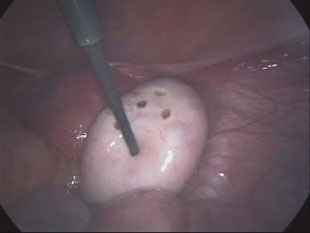Polycystic Ovarian Syndrome Symptoms, Causes, Diagnosis and Treatment | PCOS
One of the most common endocrine disorders facing a gynecologist. It is a heterogeneous disorder characterized by disruption of the normal regular process leading to ovulation and presented to the clinicians in a very wide range of symptoms and signs and sometimes accidentally discovered by routine checkup.

Etiology and pathophysiology of Polycystic ovaries:
The real cause of Polycystic ovaries PCO is unknown.
Most likely there is some sort of familial inheritance of this condition possibly autosomal-dominant, with premature balding being the male phenotype.
It appears during increased weight gain during puberty. However the polycystic ovary gene(s) has not yet been identified, and the effect of environmental influences, such as weight changes and circulating hormone concentrations and the age at which these occur, is unknown.
Clinical presentation of Polycystic ovaries:
Polycystic ovaries PCO presents in various ways:

- 1-incidental finding:- Regular-cycles patient will be asymptomatic, no signs of metabolic and hormonal disturbances and only U/S findings of PCO, which are 10 or more cysts per ovary, 2-8 mm in diameter surrounding an echo-dense stroma.
- 2- Weight gain (obesity):-
Obesity is associated with high concentration of circulating leptin which is a 167 amino acid peptide that is secreted by fat cells in response to insulin and glucocorticoids. Obesity worsens both symptomatology and the endocrine profile, so obese women with a body mass index BMI more than 30 kgs /m2 should be encouraged to lose weight.
Women with PCO have a greater frequency of hyperinsulinaemia and insulin-resistance
Obese women with PCO have hyper secretions of insulin which stimulates ovarian secretion of androgens.
- 3- Menstrual disturbances:-
- * Primary or secondary amenorrhea
- * Irregular menstrual cycles
- * Oligo menorrhea
- 4- Infertility:-
- Excessive secretion of Leutinizing Hormone is particularly associated with menstrual disturbances and infertility.
- 5-Hyperandrogenism and hirsutism:-
- Symptoms of excessive androgen secretion include hirsutism, which is characterized by terminal hair growth in a male pattern of distribution, including chin, upper lip, chest, upper and lower back, abdomen, upper arm, thigh and buttocks.
- Evaluation of the degree of hirsutism should be done in a standardized way, using a scoring system such as the modified Ferriman and Gallwey score, before and during treatment.

- 6-Recurrent abortions
- 7-Acne vulgaris
Laboratory Tests ad findings in Polycystic ovaries cases:
- - Increased androgens (testosterone and androstenedion)
- - Increased LH
- - Increased Fasting insulin
- - Increased Prolactin
- - Increased estradiol, estrone

- -decreased sex hormone binding globulin
Differential diagnosis of Polycystic ovaries
- Acromegaly
- Hyperthyroidism
- Congenital Adrenal Hyperplasia
- Cushing's Syndrome
- Hyperprolactinemia
U/S examination and findings.

The best method for diagnosing of Polycystic ovaries PCO is ultra sound examination, and the vaginal ultra sound gives 100 % detection rate as compared to 30% failure to detect PCO by abdominal U/S. The characteristic finding is (10 smaller cysts measuring 2-8 mm in diameter surrounding an echo-dense stroma).
Treatment of Polycystic ovaries:
It is mostly symptomatic treatment, i.e. according to the symptoms and the presentation of the disease.
1- Obesity:
* Weight reduction
* Metformin tablets which inhibit the production of hepatic glucose and thereby decrease insulin secretion.
*A low-calorie diet is recommended for females with BMI more than 30kg/m2 or for patients with truncal obesity
2- Menstrual irregularity :-
The easiest way to control this problem is by using low-dose combined oral contraceptive preparations. This will result in artificial non-ovulatory cycles and regular shedding of the endometrium. An alternative is progesterone, such as medroxyprogesterone acetate or dydrogesterone for five days every one to three months to induce withdrawal bleeding.
3- Infertility: -
Ovulation can be induced by antiestrogenes, clomiphene citrate (5-100 mg) or tamoxifen 20-40% mg on days two through six of natural or induced bleeding. In resistant cases, we can use parenteral gonadotrophin therapy with very careful continuous monitoring of the ovaries, or we can use laparoscopic diathermy.
4- Hyperandrogenism and hirsutism :-
Treatment options include medical and cosmetic therapies. The aim is to stop further progression of hirsutism and decrease the hair growth rate, but the patient should know that it will take at least six to nine months before any benefit is perceived, and so physical treatment, including, waxing, bleaching, electrolysis, and laser therapy, may be helpful during this time until medical treatment, shows any benefit.
Surgical treatment of Polycystic ovaries PCO

1- Wedge resection of the ovaries
This procedure resulted in extensive adhesions and ovarian tissue loss so it is replaced completely nowadays by laparoscopy.
2- Laparoscopic ovarian diathermy
It is so effective with minimal damage to the ovaries. Only minimal damage to the ovary is required to stimulate ovulation.
Possible late sequels of Polycystic ovaries:

* Diabetes Mellitus
It was found that insulin resistance can be detected before the appearance of other clinical symptoms of PCOS. In some cases, patients with only anovulation, are checked for insulin resistance.
Our current testing includes a 12- hour fasting followed by a 75g glucose challenge (sugar solution commonly used to test for gestational diabetes in pregnancy). Blood level is drawn before the glucose is administered (fasting) and at one and two hours after the glucose ingestion. The blood is evaluated for insulin and glucose. Normally, the fasting blood level will demonstrate normal range glucose and a low insulin level. After a dose of sugar, the blood-glucose level increases as well as an increase in secreted insulin. Abnormal values can indicate insulin resistance, and may be diabetes in some patients.
* Dyslipidaemia
* Hypertension
* Cardio vascular disease
* Endometrial carcinoma
Dr Najeeb Layyous F.R.C.O.G
Consultant Obstetrician, Gynecologist and Infertility Specialist







 Pregnancy Due Date Calculator
Pregnancy Due Date Calculator
 Chinese Gender Predictor
Chinese Gender Predictor
 Ovulation Calculator
Ovulation Calculator
 IVF Due Date Calculator
IVF Due Date Calculator
